Data from the 2022 Annual Household Income and Expenditure Survey has revealed that 49.1 percent of the Ghanaian population was food insecure in the first quarter of the year.
This represents 15.1 million of the 30.8 million persons in Ghana.
The percentage however reduced to 42.1 percent in the second quarter; 13 million of the total Ghanaian populace.
Regional basis
The Greater Accra Region recorded the lowest food insecurity with a percentage of 27.2 percent, while the Upper East Region saw the highest of 73.7 percent.
In the first quarter of the year, the prevalence of food insecurity in four regions in the northern part of the country; Savannah (58.8%), Upper West (61.8%), North East (65.6%) and Upper East (73.7%) were more than twice that of Greater Accra Region (27.2%).
It is also observed that all regions experienced a reduction in food insecurity between quarters 1 and 2 except for the Upper West Region which saw an increase from 61.8 percent to 55 percent.
Meanwhile, Oti and Western North regions experienced the largest declines of 19.6 and 18.7 percentage points respectively.
The Annual Household Income and Expenditure Survey is the first nationally representative high-frequency household panel survey in Ghana.
The Survey, conducted by the Ghana Statistical Service, is being conducted to obtain quarterly and annual data on household final consumption expenditure and a wide scope of demographic, economic and welfare variables including statistics on labour, food security, multi-dimensional poverty and health status for research, policy, and planning.
The maiden publication presents highlights from the first and second quarter food insecurity, multidimensional poverty, and labour statistics reports.
Click here to read the full report
Source: citifmonline


Comments